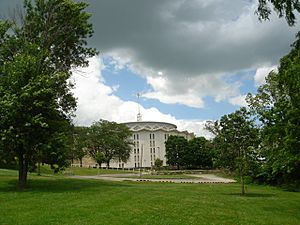Sinsinawa, Wisconsin facts for kids
Quick facts for kids
Sinsinawa, Wisconsin
|
|
|---|---|

Sinsinawa
|
|
| Country | |
| State | |
| County | Grant |
| Towns | Jamestown, Hazel Green |
| Time zone | UTC-6 (Central (CST)) |
| • Summer (DST) | UTC-5 (CDT) |
| Area code(s) | 608 |
Sinsinawa is a small, quiet community in Grant County, Wisconsin, United States. It is an unincorporated community, meaning it does not have its own local government like a city or village. Sinsinawa is located in two towns, Jamestown and Hazel Green. It sits just one mile north of the border with Illinois.
This community is about 7.5 miles east of Dubuque, Iowa. It is also about 6.5 miles west of the village of Hazel Green, Wisconsin. Sinsinawa is most famous for being the main home of the Sinsinawa Dominican Sisters.
Contents
History of Sinsinawa
The name "Sinsinawa" comes from the Sioux language. It can mean either "rattlesnake" or "Home of the Young Eagle".
Early Settlers and Lead Mining
The first European-American settler in this area was George Wallace Jones. In 1827, he bought land to build a lead smelter. A smelter is a place where metal is taken out of rock.
Founding of the Dominican Order
Soon after, George Wallace Jones sold his land to a Dominican priest named Samuel Mazzuchelli. Father Mazzuchelli was very important to the community. In 1846, he built a college for men called Sinsinawa Mound College.
The Sinsinawa Dominican Sisters
Father Mazzuchelli also founded a group of religious women called the Sinsinawa Dominican Sisters. He started this group in 1847. These Sisters later opened a college and a high school for women in Sinsinawa in 1865.
Sinsinawa Mound: A Special Hill
Sinsinawa Mound is a cone-shaped hill in the area. This hill is where the community gets its name. The Sinsinawa River flows along the south side of the hill. It eventually runs towards the Mississippi River in Illinois.
Black Hawk War Connection
A historical event called the Sinsinawa Mound raid happened near Sinsinawa Mound. This raid took place on June 29, 1832. It was part of a larger conflict known as the Black Hawk War. In August 2007, people gathered to remember the 175th anniversary of this war.



